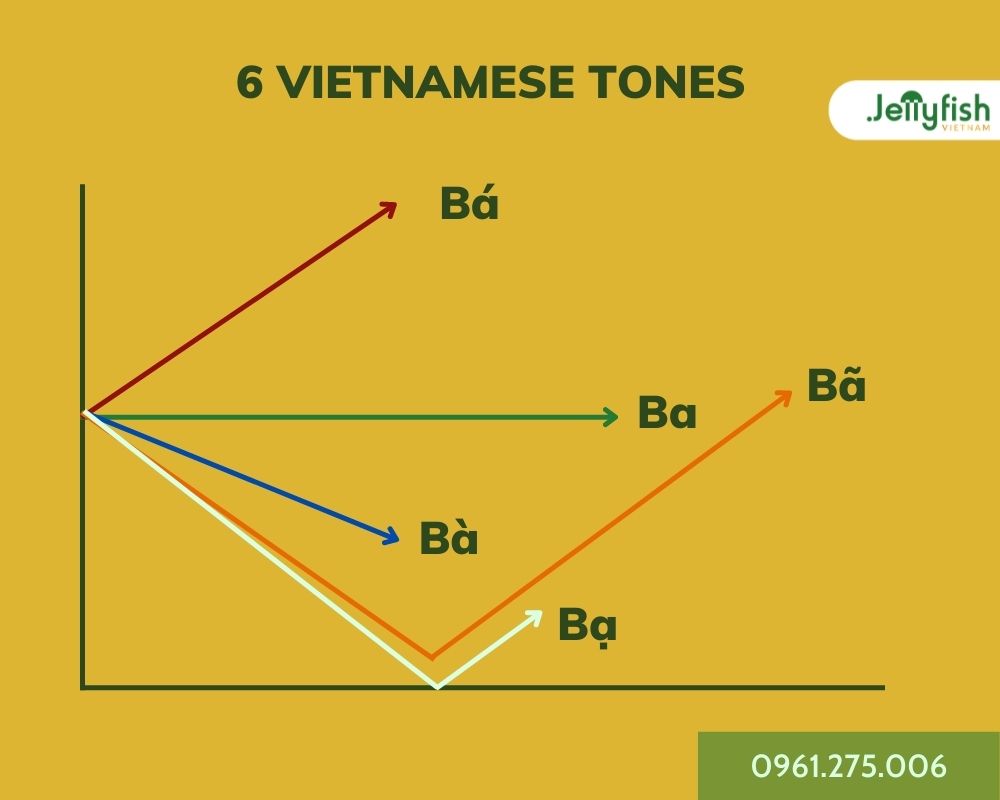You are a foreigner living and working in Vietnam? You want to live for a long time in Vietnam and want to speak Vietnamese everyday like a native speaker. Here is a summary of difficulties and advantages when learning Vietnamese and 6 notes helping you to speak Vietnamese like a native speaker. Let’s follow us!
1. Is it difficult to speak Vietnamese like a native speaker?
Vietnamese people often say that: “The hardships of struggling with a violent storm don’t compare to the hardships of mastering Vietnamese grammar“, meaning that Vietnamese is truly difficult, especially to speak and understand like a native speaker. This occasionally hesitates foreigners to start learning to speak Vietnamese.
However, in fact, Vietnamese is not as difficult as many people think. Apart from the difficulties in pronunciation and communication, Vietnamese also has advantages that are easier to learn than other languages.
1.1. Difficulties in learning to speak Vietnamese
In order to listen, understand and speak Vietnamese fluently, you will have to overcome 3 challenges listed below:
1.1.1. Vietnamese has numeric tones – Speaking difficulties
When other languages have almost no tones, Vietnamese has 6 tones in total. Each tone in Vietnamese is equivalent to 1 tone mark, in other word a level, without accents. 5 tone marks in Vietnamese include:
- Acute: (´) . Examples: Á, Ó, Ố, Ú, Ứ, Ý, Í,…., Cá, Có, Cú,….
- Grave: (`) . Examples: À, Ò, Ồ, Ù, Ừ, Ì,…, Cà, Cò, Cù,…
- Hook above: (?). Examples: Ả, Ỏ, Ổ, Ủ, Ử, Ỷ, Ỉ,…, Cả, Cỏ, Củ,…
- Tilde: (~). Examples: Ã, Õ, Ỗ, Ũ, Ữ, Ỹ, Ĩ,…, Cỗ, Cũ, Kỹ,…
- Underdot: (.): Examples: Ạ, Ọ, Ộ, Ụ, Ự, Ị,…, Dạ, Cọ, Cộ, Cụ, Kị,…

Same letter, in just different tone mark, presents different meaning:
Examples:
- Ca(Level): meaning sing or a plastic cup in Vietnamese
- Cá(Acute): meaning a fish
- Cà(Grave): meaning an eggplant
In addition, not all words and marks can pair up (Example: The word “But” can only pair with underdot and acute, not with the other three). This is one of the most challenging difficulties when foreigners start to speak Vietnamese.
See more: Vietnamese Slang: 20+ Must-Know Words for Speaking Like a Native
1.1.2. Vietnamese has many pronouns
In Vietnamese has many pronouns which are identified according to the age, gender and the relationship between speaker and listener.
Some common personal pronouns in vietnamese can be mentioned such as:
- Chị: Used to call someone who is older than you and is a female. In this situation, the speaker will be addressed as “Em”.
- Anh: Used to call someone who is older than you and is a male. In this situation, the speaker will be addressed as “Em”.
- Em: Used to call someone who is younger than you, or used to call your cousin, your younger brother. In this situation, the speaker will be addressed “Anh” or “Chị”
- Cô/chú/bác: “Cô” is used to call your relative who is younger than your parents and is a female. “Chú” is used to call your relative who is younger than your parents and is a male. “Bác” is used to call your relative who is older than your parents. In this situation, you will be addressed as “Cháu”.
Also, there are some other common words such as: Ông/bà, Con, Tôi, Tớ, Bạn, Mày, Tao,..to name a few
1.1.3. Vietnamese has up to 3 main accents
Vietnamese has 3 different dialects according to 3 regions: North – Central – South respectively. The differences in pronunciation among 3 regions can cause confusion and misunderstanding to foreigners Here are some of the most remarkable differences when you speak Vietnamese using three different dialects:.

- North: Northern people have the most standard pronunciation according to common Vietnamese pronunciations. However, when most Northern people pronounce, they will not distinguish “s” and “x”, “r” and “d”, “ch” and “tr”.
Examples: bức “tranh” => bức “chanh”; con “sâu” => con “xâu”
- Central: People in the Central region often use mixed question marks and tildes
Examples: Lên “xã” => lên “xả”; nước “lã” => nước “lả”
The diphthongs are changed into: Examples: ương => ưng – Bướng => Bứng
- South: Southern people often skip accompaniment when speaking.
Examples: Luật => Lục – Toàn => Tàu,…
The sound “iêu” hay “yêu” is often pronounced “iu”: Examples: Không “hiểu” => Không “hỉu”
See more: Learning Vietnamese online for foreigners [Best Price] 2024
Excluding the differences in pronunciation, people from different regions usually use different words to talk about the same objects or things.
Examples: The word “Quả dứa” – The Southern people call “Trái thơm”, some areas in the Central call “Trái Khóm” or “Trái gai”
However, there are not so many words like that, you do not need to worry.
1.2. Advantages when learning to speak Vietnamese in comparison with other languages
In addition to the above difficulties, learning to speak Vietnamese also has advantages in comparison with other languages, not too difficult as many people imagine.

1.2.1. Vietnamese is a monosyllabic language
Different from English, Vietnamese is a monosyllabic language, each word in this language has only 1 rhythm so it is easier to memorize and speak.
Example: The word “Happy” in English has up to 2 rhythms. But in Vietnamese, all the words only have 1 rhythm. (Có, Cá, Cà, Cả, Bà,….)
Besides, words can also be put together easily in order to create a new word:
Xe + Máy => Xe máy/Motorbike
Xe + Ô tô =? Xe ô tô/Car
Xe + Đạp => Xe đạp/Bike
1.2.2. Vietnamese grammar is fairly simple
English grammar is structured by tenses, sentences are made by different rules, but Vietnamese is not the same. Vietnamese grammar is quite simple, mainly when speaking Vietnamese, you just need to put words together.
- Vietnamese does not have masculine nor feminine:
French, German and many other languages often divide subjects, verbs by gender, but Vietnamese does not. There will be no masculine or feminine concepts for vocabulary, you just need to memorize each word without having to learn by heart anything else.
- Vietnamese does not have article “a” “an” “the”
English has 3 articles “a” “an” “the” with complicated rules that not everyone can remember and uses 100% correctly. However, Vietnamese in fact has no articles, you can speak Vietnamese naturally without having to memorize any rules.
- Vietnamese does not have a plural
In English, when you want to say something in the plural form, you must add “s” or “es” but Vietnamese does not.
Example: “House” in plural would be “Houses”. But in Vietnamese, “Ngôi nhà” in plural also would be “Ngôi nhà”
- Vietnamese does not have tenses or different types of verbs.
Example: If in English, the word “speak” has many different types of verbs such as “Speaks”, “Spoken”, “Speaking”, “Spoke”, in Vietnamese, the word “Nói” always be “Nói” in all situations.
From the examples above, you can see that learning to speak Vietnamese is not as difficult as many people think.
2. 6 Notes to help you speak Vietnamese like a native speaker
Here are some golden notes to help you practice and speak Vietnamese naturally like native speakers.
2.1. Do not be afraid of speaking incorrectly, speak Vietnamese as frequently as you can.
When learning a new language, many people are often afraid of speaking the language incorrectly, so they are afraid to speak or communicate in that language. However, if you do not speak, you will never improve and you will not know where you are wrong to correct.
Then, do not hesitate to speak Vietnamese usually. You will find Vietnamese people not laughing at your mistakes, versus, they are willing to help you improve.
2.2. Communicating more with native speakers
Communicating with native speakers as much as possible, because:
- Native speakers can correct your pronunciation
- Usually communicate with Vietnamese people which helps to improve your Vietnamese reflexes.
- Helps to improve your vocabulary and word usage in Vietnamese. When you communicate, you will also learn slangs, idioms, funny sayings that Vietnamese people often use.
2.3. Learning Vietnamese by communication topic
Instead of learning many things at the same time, learn to speak Vietnamese by topic one by one and practice it “a thousand times”. Some topics to practice speaking Vietnamese effectively for beginners such as:
2.4. Applying “Shadowing” method to practice listening and pronouncing
“Shadowing” is a method which is applied commonly when learning a new language. This method will help you improve your listening and speaking Vietnamese effectively and be more confident when communicating with native speakers.
In a nutshell, this method is applied as follows:
Step 1: Finding listening material (short films, short news,…) Having Vietnamese subtitles is better.
Step 2: Listening and repeating each sentence to make sure that it is exactly like the material. Repeating over and over again.
Step 3: Listening 2-3 sentences at the same time and repeating until you speak fluently, naturally.
2.5. Learning to speak Vietnamese with your local dialect
There are many foreigners learning local Vietnamese by App or by online lessons and when communicating in reality, they struggle to understand because of dialect disagreement.
Therefore, in the process of learning Vietnamese, we suggest learning about dialects, how words are pronounced in three different regions. If you plan to learn and reside for a long time in Ho Chi Minh city, try to find a Southern teacher and practice speaking Vietnamese according to Southern people’s pronunciation.
2.6. Avoid learning Vietnamese by yourself!
Vietnamese is not too difficult but it is truly a challenge for you to learn by yourself and considerably impossible. In order to avoid basic confusion or wrong understanding at first, find a prestigious Vietnamese learning center or learn with experienced native teachers. Do not learn by yourself through App or recorded online lessons because you cannot communicate with the teacher. The teacher also cannot correct your pronunciation when you say it incorrectly.
Here are 6 tips to help you learn to speak Vietnamese like a native speaker. Hope this article provides you with useful information.
If you have any questions or need advice on how to learn and Vietnamese language learning route, do not hesitate to reach out to Jellyfish Vietnam for support.
For more information and free consultancy, please fill the form below! We will reach out to you!
Jellyfish Vietnam – Hotline: 0961.106.466
Please fill out the registration form for Vietnamese language course consultation if you need it!
https://learningvietnamese.edu.vn




